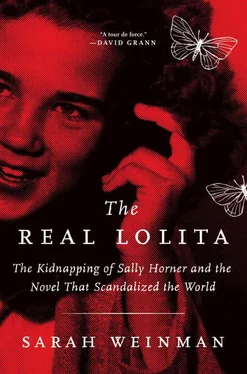As the months wore on, she lost jobs and found others. Sometimes she couldn’t pay her bills for weeks. Sometimes the phone got disconnected, or the electricity was shut off. Periodically, Ella would go to Florence to stay with Susan and look after her granddaughter. Otherwise, Ella was alone. Alone to contemplate again and again the ways in which she held herself responsible for Sally’s disappearance.
Sally Horner disappeared a few months after Mitchell Cohen was appointed as prosecutor for Camden County, a ten-year term that would last until 1958. He was already on the way to becoming the pivotal law enforcement figure in the city, a status that saw his name emblazoned, decades later, on the downtown federal courthouse. Taking on the prosecutor gig only bolstered his reputation. In the late 1940s, Camden County did not have enough major crime to justify a full-time prosecutor. So Cohen worked in spurts, spending the rest of his time on Republican party politics. He was so successful at it that he became the state party’s de facto leader, allied closely with the New Jersey governor of the day, Alfred Driscoll.
Cohen’s term as prosecutor was one of many jobs he held in law enforcement over a long legal career that stretched from early private practice with local law firms all the way to chief judge for the federal district court of New Jersey. He moved smoothly between prosecuting criminals and delivering judgments. Cohen wasn’t one to bask in career glories, though. He was far too busy working to spend much time reflecting on the past.
Cohen did, however, take the time to dress the part of a big-shot lawyer. In his bespoke suits, he cut a figure that landed somewhere between David Niven and Fred Astaire. One lawyer told Cohen’s son, Fred, “Whenever I appeared in front of your father, I felt I wanted to wear a white tie and tails and be at the top of my game because he was a classy guy.”
Any resemblance Cohen bore to famous actors was, perhaps, intentional. He caught the bug for theater early in life, making trips up to New York to see Broadway shows a priority. In his younger years, Cohen spent his Saturday nights in line for concerts and stage performances at Philadelphia’s Academy of Music, angling for a twenty-five-cent seat in the gallery. Once established in his legal career, he could afford to split a box seat with a friend.
He’d met Herman Levin at South Philadelphia High; they remained pals even after Cohen’s family moved to Camden just before his senior year. The boys made a point of seeing every play in Philadelphia—long a city where Broadway-bound shows worked out problems and test-ran productions on audiences—on opening night. Levin ended up producing musicals like Gentlemen Prefer Blondes, Destry Rides Again, and My Fair Lady . Before the latter show opened in 1956, Levin told Cohen to “hock everything he had in the world” to invest in the production. Cohen did, and reaped the benefits as My Fair Lady smashed box-office records. Cohen also became a theatrical producer himself, cochairing the short-lived Camden County Music Circus during the summers of 1956 and 1957.
But Cohen’s fashion sense, his theatrical interests, and even his political machinations did not overshadow his commitment to jurisprudence. Cohen cared about the law and about being fair. He believed it was as important to know when not to prosecute a case as when to prosecute. In 1938, early in his tenure as acting judge for the city of Camden, a husband and wife appeared together in his courtroom after she had attempted suicide by poison—back then a punishable crime.
“We had a quarrel, and I thought he didn’t love me anymore,” the twenty-eight-year-old woman told Cohen.
“Do you?” Cohen asked her husband, who was twenty-nine.
“I sure do.”
“Then go home and forget about it.”
Cohen didn’t seek out notorious cases. They found him. When he won a trial, he didn’t dwell upon the details. Those cases, and how Cohen approached them, are an important window into 1940s Camden, as well as the forces that set the city up for great societal changes.
WHEN MITCHELL COHEN set out to prosecute the men responsible for the murder of Wanda Dworecki in the fall of 1939, he had never worked on a capital case before, even though he’d been appointed city prosecutor for Camden three years earlier. Murders were rare then, a far cry from the statistics that designated the city as America’s murder capital as recently as 2012. The strangulation of a girl a month shy of her eighteenth birthday stood out in its singular brutality.
Wanda’s body was discovered on the morning of August 8, 1939, in an area near Camden High School frequently used as a lovers’ lane. A corsage of red and white roses adorned her neck. The killer strangled her so forcefully that he broke her collarbone and breastbone. Then he dropped a rock onto her head, fracturing her skull.
Police working on the case weren’t all that surprised Wanda had died so violently. Four months before her murder, in April 1939, two men had accosted Wanda on the street and thrown her into their car. They beat her up—a near-fatal assault—and tossed her out into a field in a desolate part of Salem County, just south of Camden. She spent weeks recovering in the hospital.
That beating wasn’t Wanda’s first brush with violence. In late 1938, she and a friend had been out walking in the neighborhood when several men tried to kidnap them. Police were convinced—or at least, this is what they said—that Wanda was “destined to be murdered.” What they would soon learn is how much one man manipulated things so that destiny would become reality.
Wanda’s father, Walter Dworecki, who had emigrated from Poland in 1913, appeared to be an upstanding figure. He preached at the First Polish Baptist Church, a congregation he’d founded when the family moved to Camden from rural Pennsylvania. His teenage daughter troubled him, especially after her mother, Theresa, collapsed at the breakfast table and died in 1938. He brooded over Wanda’s fondness for the opposite sex, lecturing her about preserving her virtue, verbally abusing her in such a way to make an example of her to her younger siblings, Mildred and Alfred.
Respectable appearances can hide awful secrets, and Dworecki had plenty. Like being out on bail for setting fire to a house in Chester, Pennsylvania, in a scheme to collect insurance. Or having been sentenced to five years’ probation for passing counterfeit money. Like getting so angry at a neighborhood boy that he allegedly fractured the teen’s jaw with a broomstick. Or taking out a $2,500 life insurance policy (nearly $45,000 in 2018 dollars) on his wife, Theresa, whose cause of death was officially “lobar pneumonia”—the same cause of death listed for a number of victims of a murder-for-insurance scheme in Philadelphia whose culprits had some connections to the preacher.
The secret Walter Dworecki should have tried harder to keep was his fondness for hanging around Philadelphia dives, looking for men who might be willing and able to kill his daughter.
Immediately after Wanda’s murder, Dworecki slipped into the role of grieving father. He cried, “My poor Wanda!” when he saw his daughter’s body at the morgue, and then fainted. He had an alibi for the time of her death, but his grief-stricken act cracked quickly once police started to investigate.
A witness had seen Wanda with a “large blond gentleman” the night before she was murdered, who turned out to be twenty-year-old Peter Shewchuk, who boarded at the Dworeckis’ and romanced Wanda every now and then. When Shewchuk learned he was wanted for questioning, he fled Camden for his boyhood home in rural Pennsylvania. Police caught up to him on August 27, after his father turned him in.
Читать дальше












